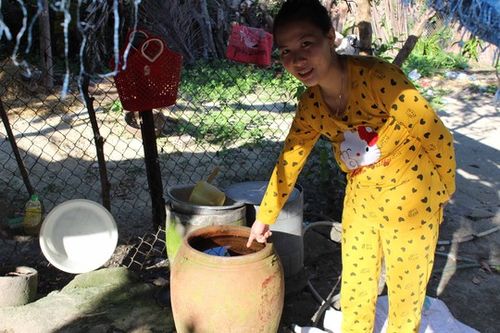VietNamNet Bridge - Not only do they suffer pain due to illness and poverty because of poor health, hundreds of households in Quy Hoa leprosy village in Quy Nhon City have been suffering from polluted water.

Located in a small valley, surrounded by the mountains and the sea, the Quy Hoa leprosy village, with 600 households, is four kilometers far from Quy Nhon City. Half of the villagers, leading difficult lives due to illness, have been living on annual allowance.
However, leprosy and poverty are not the only things the local residents are facing. They also have to struggle with other diseases caused by polluted water they use daily.
Pointing to the bucket of water, muddy and yellow, Nguyen Van Mot, 59, said the water had just been pumped from the water well in his house.
“Here we don’t have tap water. Therefore, we have been using the alum-infected water for cooking and washing over many years,” he said.
Mot, like other locals, tries to ease pollution by filtering the water several times after being taken from wells. However, the filtration cannot help, and the water still emits a bad odor.
A man of the Quy Hoa leprosy village said many years ago they also used the water from the wells they dug. The water was then clean and safe enough. However, as the underground water is now seriously contaminated with alum, the water has turned unsafe.
“We tried to seek water at the depth of tens of meters in the earth, but our efforts were in vain,” the man said. “We have no other choice than living together with the polluted water, and asking for the local authorities’ help.”
Tran Quy Lanh, a local authorities’ official in Ghenh Rang Ward, said a lot of the villagers have intestinal and skin diseases.
“We have been repeatedly asking for help over the last few years, but there has been no reply,” he said.
“The residents of the leprosy village have been too miserable because of illness. I will ask the local authorities if they can help ease their misery,” he said. “They need clean water.”
An official said that a feasibility study on building a clean water supply system in the area was drawn up in 2013.
In late 2014, the provincial authorities, after many delays, released a document assigning the local planning and investment department to allocate a budget for the project, estimated to cost VND12 billion. However, the project implementation has not kicked off.
Nguyen Thanh Hai, deputy director of the Binh Dinh Investment and Planning Department, when asked about the project, said his department “is considering allocating budget to the project”.
NLD